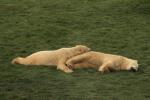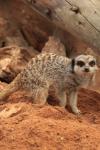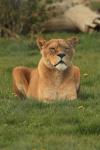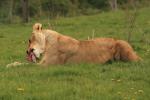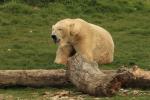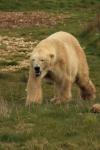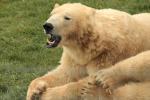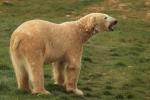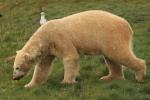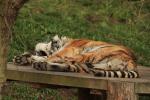Thursday 11th April 2019
It was another cold start to the day, 2C, fine and dry with a little early morning mist.
We had one Jenny’s grandchildren staying on a ‘sleepover’ last night and although I was woken by him at 5.00am I managed to persuade him to stay in bed for at least another thirty minutes. Meg and Gracie weren’t in the least bit bothered about an early start to the day and thought it great fun to have more play and walk time!
We decided after breakfast to drive over to the Yorkshire Wildlife Park on the outskirts of Doncaster, to see the animals and to burn off some of his endless energy. It is only a drive of about forty minutes from home so it is reasonably close. We left the dogs at home, both grateful for a couple of hour’s peace and quiet before our return.
I am not a great lover of zoos generally but I very much enjoy visiting this wildlife park not just for photographing the animals but I like the way the centre puts an emphasis on the welfare and conservation of the animals. Built on a former riding school and farm, Yorkshire Wildlife Park has been open since April 2009. It has certainly come on a long way since those early days. Today the park has over 400 animals and over 70 different species of animal.
Obviously todays visit was about spending some quality time with our grandson, taking photographs was secondary. Arriving at around 10.30am I could not believe how full the main car park was, the park had only been opened since 10.00am and was at least three quarters full. I think some of the schools, especially in West Yorkshire were having an early Easter holiday and that parents and grandparents were having the same train of thought as us about getting their offsprings out into the open fresh air if only for a few hours.
After passing through the entrance we came upon the Meerkats and Mongoose, several were out and about in their compound, I love the way they always have a ‘guard’ on duty sat bolt upright on the highest rock, watching over the pack keeping an eye open for any predators, just as they would in the wild. From the Mongoose and meerkats enclosure we continued our journey around the park in an anti-clockwise direction, heading for ‘Lion Country’. It was the Lions story that first made me aware of Yorkshire Wildlife Park some ten years ago. The pride where rehomed from the Oradea Zoo in Romania where due to lack of funds and expertise were kept in very poor conditions. At the time, Lion Rescue was the largest big cat rescue in Europe. They now live a completely different life, contently roaming amongst their seven acre reserve. Today they looked good as they walked around their reserve, one or two of them busily feeding whilst the others were sleeping contently in the morning sunshine.
After leaving ‘Lion Country’ we headed over to ‘Wallaby Walkabout’ and had a walk through their enclosure. The Bennet Wallabies are native to Australia and Tasmania and roam free within their enclosure amongst the members of the public. The most noticeable thing about marsupials like wallabies is the females unique pouch, used to nurse their young, a joey will stay in its mum’s pouch, drinking her milk, until they are about six months of age. After six months of age they will come out of the pouch to hop around, but will continue to return to mum’s pouch until they can no longer fit! Several of the Wallabies were carrying their Joey’s during our visit. On leaving the Wallabies we headed over to the ‘Project Polar’ to look at the Polar Bears.
The Project Polar reserve is home to four polar bears, Victor, the oldest bear who arrived at YWP in August 2014, now retired from the European breeding programme after siring 10 cubs, his grandson Pixel who arrived at the park on the 25th March 2015 from Holland, Nissan who arrived all the way from Moscow on the 13th October and YWP’s latest arrival, Nobby who arrived from Munich on the 18th February.
The Polar Bear reserve covers some 10 acres and features several lakes, the largest one of the lakes covers an area of 6,500 square metres, containing over 25.5 million gallons of water. The 8 metre deep lake is fantastic for Victor, Pixel, Nissan and Nobby to swim, dive and play in. Today we missed the bears swimming in the lake but watched as one of them fed on a huge piece of meat whilst two others were quite content to cuddle into each other and have a snooze. The reserve has been built to reflect the habitat of the summer Arctic tundra. The polar bear population of South Hudson Bay spend up to 7 months of the year on habitat like this – and not snow and ice! The temperatures in summer can reach up to 26 degrees C. so they are quite at home in their ‘new’ surroundings here.
After leaving the Polar Bears we followed the trail through the ‘Wetlands’ and into ‘The Land of the Tiger’, which is home to the endangered Amur Tigers ‘Vladimir’, ‘Sayan ‘and ‘Tschuna’. The ‘Land of the Tiger’ is one of the largest tiger reserves in Europe and was built in 2011 and whilst the story of the lions was all about welfare – the tigers are part of the European Breeding Programme and their story is all about the conservation of this beautiful endangered species and the threats they face. It is thought that there are less than 500 Amur tigers left in the wild, hunting had pushed these animals to the brink of extinction in the 1940’s, with only 40 remaining in the wild. The species was saved when Russia granted the Amur tiger full protection and since the 1940’s a significant amount of work has gone into the conservation of these magnificent animals. Land of the Tiger is world renowned and one of the largest tiger exhibits in Europe. Tschuna was originally hand reared by keepers at a zoo in Germany after being rejected by her mother, before coming to the UK and arriving at YWP in 2013, a move recommended by the European Breeding Programme. After being introduced to the male tiger Vladimir, she gave birth to three cubs in March 2015 and turned out to be a great mother. Needless to say that on our visit today they were both resting in the shade.
After our visit to see the Tigers we headed back to the Masai Coffee shop, the weather being quite kind to us so we sat outside and enjoyed the sunshine and brunch. After our short break I headed round the corner to see the Brown Bears. Like the lions we saw earlier the four Ussuri Brown Bears have been ‘rescued’ from a zoo in Japan where they had been living in very cramped conditions for many years. Riku, Kai, Hanako and Amu were previously housed as part of an exhibit in outdated cages at the Ainu Cultural Museum on Hokkaido, the northernmost of Japan’s islands and urgently needed new facilities. Unfortunately, there was no capacity in Japanese zoos to take them, so the Yorkshire Wildlife Park stepped in. The work involved to move the four bears took over two months of planning and preparations to create a safe and efficient journey for the 5,400 miles trip from Japan to the UK. The four bears, travelled with one of YWP’s Animal Managers and vets were transported in temperature-controlled conditions on the cross-continent transfer which took over two days. After a period of rehabilitation at the YWP the bears look to have settled in really well and enjoying their new surroundings. Today though they were exploring the far side of their reserve so although not out of camera range I could not get any suitable images, will have to try again on our next visit.
It is the stories of the Lions and Bears which make me respect the work being done by the YWP and associated organisations to safe guard these animals for the benefit of their lives and for future generations, long may it continue.
|

